Heidekolb's Blog
“Downwards is the only way Forwards” ~ INCEPTION ~ A Jungian Perspective
1 Comment
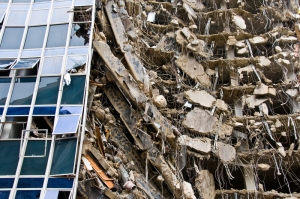 Worlds collapsing on itself, upwards, downwards, forwards, gravity no more. Narratives weave themselves in and out and around the globe. What the hell is going on here? What is reality? Ego wants to know.
Worlds collapsing on itself, upwards, downwards, forwards, gravity no more. Narratives weave themselves in and out and around the globe. What the hell is going on here? What is reality? Ego wants to know.
I am emerging out of the fluid and often violent scenery of the movie “Inception”. Be warned, if you have not seen the film, not much of what I am saying will make sense. If you have seen the film, you will probably have given up on the need to make sense. If that is the case, congratulation ~ the film has already succeeded. Welcome to the world of process, dreams and to the dream we call life as it presents itself just a few breaths below the threshold of waking consciousness. Memories, dreams, reflections is not only the title of Jung’s so-called autobiography but also the stuff we perceive as reality. Dare we drop the guard, tilt, fall and swim? Will we drown in chaos and random meaninglessness?
Leonardo DiCaprio, in the role of Cobb, a professional invader of the mind and corporate raider is both the heroic action protagonist and the subject of the trajectory of intercepting dream sequences. As in life, outer and inner are seamlessly intertwined. In Jungian terms, the personal and the archetypal overlap, feed each other and it is only our ego that needs to separate these two dimensions of experience.
At the core of the film we are witnessing Cobb’s journey to the roots of his feelings of guilt. He believes he planted (incepted) thoughts into his wife’s mind which led to her demise and suicide. He is aided in his descent by a young woman, Ariadne, recommended by this late wife’s father, who is the architect of the imaginal dream landscape. In Greek mythology, Ariadne helps the hero Theseus escape a deadly labyrinth, only to be betrayed and abandoned by him shortly afterwards. (My previous post, “Ariadne and the Minotaur” might be of interest). In some versions of the myth Ariadne kills herself.
The Ariadne in Cobb’s life (dream) may be another aspect of his inner feminine, just as is Mal, his late wife. Who are the figures that populate our waking dream of life?  Where is the intersection of outer reality and our psyche’s projection on her journey home to the center? Psyche expresses herself not only in visual image and affect, but also in sound. Repeatedly we hear Edith Piaf’s voice “Non , je ne regrette rien” ~ “No , I don’t regret anything” as if another aspect of the feminine responded to Cobb’s feelings of guilt. Oh, and of course, whoever saw “La vie en Rose” will remember that Edith Piaf was brought back to life, truly it appeared, by Marion Cotillard, who portrays Mal, Cobb’s wife and source of his guilt. Whose reality are we experiencing? Are you in my dream am I in yours? Layer upon layer ~ circling around a center ~ the mandala of the forever revolving life.
Where is the intersection of outer reality and our psyche’s projection on her journey home to the center? Psyche expresses herself not only in visual image and affect, but also in sound. Repeatedly we hear Edith Piaf’s voice “Non , je ne regrette rien” ~ “No , I don’t regret anything” as if another aspect of the feminine responded to Cobb’s feelings of guilt. Oh, and of course, whoever saw “La vie en Rose” will remember that Edith Piaf was brought back to life, truly it appeared, by Marion Cotillard, who portrays Mal, Cobb’s wife and source of his guilt. Whose reality are we experiencing? Are you in my dream am I in yours? Layer upon layer ~ circling around a center ~ the mandala of the forever revolving life.
In other versions of Ariadne’s myth, she does not commit suicide, but Hermes interferes and reunites Ariadne with her true husband Dionysus. The great God Hermes, the patron of depth psychology is the bringer of dreams. Like Cobb himself, Hermes is a thief and a messenger from the archetypal realm, a shapeshifter and protector of travelers, the guide of souls into underworld, the protector of boundaries and also the one who blurs them. When inner and inner outer world bleed into each other, it is Hermes who stands at the gate.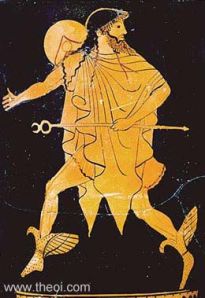
In Jungian thought we are not the creators of our thoughts, ideas and dreams. We are the vessels which receive them. But “someone had to create the dream” Cobb remarks. Hermes may bring us the dreams but who created them?
This questions leads to the most interesting image in the film. The image of the spinning top. A small object in Cobb’s possession which, as long as it is there and spins, serves as a reminder that he is in a dream. It is an anchor to not lose ones footing in the forever shifting shapes of perceptions and projections.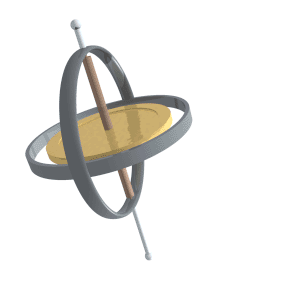 The gyroscope comes to mind and the Dreidel in Jewish culture. The gyroscope is a device for measuring and maintaining orientation. Its applications include navigation when magnetic compasses do not work, as in the Hubble Telescope.
The gyroscope comes to mind and the Dreidel in Jewish culture. The gyroscope is a device for measuring and maintaining orientation. Its applications include navigation when magnetic compasses do not work, as in the Hubble Telescope.
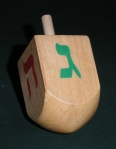 The Dreidel is a four-sided spinning top. Each side of the Dreidel is covered with a letter of the Hebrew alphabet which together form the acronym for “a great miracle has happened here”. The word Dreidel itself comes from “dreyen” and means to turn. (info & images of gyroscope & Dreidel are from Wikipedia).
The Dreidel is a four-sided spinning top. Each side of the Dreidel is covered with a letter of the Hebrew alphabet which together form the acronym for “a great miracle has happened here”. The word Dreidel itself comes from “dreyen” and means to turn. (info & images of gyroscope & Dreidel are from Wikipedia).
If there is a device to navigate cosmic space, do we have an equivalent for inner space? Jung certainly thought so and this inner dynamic is contained in the image of the Mandala.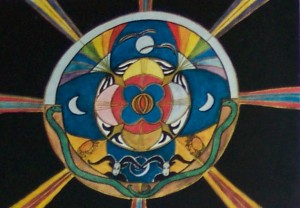 The mandala is NOT a static image. It depicts a turning, spinning and spiraling motion around a centering pole. It is a correspondence of the cosmic Tree of Life. Many cosmologies viewed this image and dynamic as a reflection of the creator matrix we call God. As above so below.This dynamic is at the center of our psychic life. As long as it spins, the great miracle of life holds us together as we forever dream downward and forward on humanity’s journey back home to the center.
The mandala is NOT a static image. It depicts a turning, spinning and spiraling motion around a centering pole. It is a correspondence of the cosmic Tree of Life. Many cosmologies viewed this image and dynamic as a reflection of the creator matrix we call God. As above so below.This dynamic is at the center of our psychic life. As long as it spins, the great miracle of life holds us together as we forever dream downward and forward on humanity’s journey back home to the center.
On Jungians, Solstice and the Death of the King – The Red Book Reflections. C.G.Jung
2 Comments
 The publication of the Red Book (RB) has rekindled much interest in Jung and his world. People are fascinated with its imagery and often inexplicably moved by it. What is it about this book? Many people feel its soulfulness, literally, when they first hold it in their hands. The Red Book is in the truest sense of the word awesome. But what to do other than admire it? Who has access to Jung’s at times elusive knowledge? Is it only the world of Jungian analysts who inherit Jung’s world? That would be terrible. Jung would abhor that thought.
The publication of the Red Book (RB) has rekindled much interest in Jung and his world. People are fascinated with its imagery and often inexplicably moved by it. What is it about this book? Many people feel its soulfulness, literally, when they first hold it in their hands. The Red Book is in the truest sense of the word awesome. But what to do other than admire it? Who has access to Jung’s at times elusive knowledge? Is it only the world of Jungian analysts who inherit Jung’s world? That would be terrible. Jung would abhor that thought.
Are those who have experienced an in-depth Jungian analysis his rightful heirs? Maybe. There is a lot to be said about working closely, intimately with someone who has walked the walk before. There are plenty of wonderful Jungian analysts out there. But unfortunately psychoanalysis has been assimilated by the medical model and has lost, by and large, its connection to soul. It is a shame. Psychology is the science of the soul, but it has deteriorated into a mere management of symptoms for the most part. Mainstream psychology has forgotten that symptoms are messages from the soul.
Jungian work is soul work. There may be other ways than the traditional route. Jung did not want us to emulate him. Psychoanalysis was originally conceived as a new “Weltanschauung, a new world view, a new way of experiencing reality. Jung was particularly interested in rescuing the soul out of the clutches of what he experienced as a stifling dogmatic Christianity.
In the book “Who owns Jung?” ( by Ann Casement), the analyst Joe Cambray answers the question with “the one who emerges from Jung”. What does emerge for you out of an encounter with Jung? Where does Jung take you? What does Jung mean to you? When we look for meaning we get in touch with the soul.
Jung held on to his soul. He held on to his longings and his felt sense of wonder beyond the visible world. He held on to his visions outside the world of reason. He maintained an unwavering trust in her. “My path is light” his soul says and Jung answers in his vision, “Do you call light what we men call the worst darkness?” “I have become a monstrous animal form for which I have exchanged my humanity”, Jung reports from the same vision. His trust is tested to the brink. He becomes angry at his soul.
I wonder if anyone has ever experienced that when trying to be truthful to oneself, following one’s path, one ends up in a spot where one did not want to be at all? When self-reflection only conjures up accusatory self attacking images? How can one have trust, faith, in an elusive guidance from the invisible world that has lead one so astray? The rational mind will say that one has lost it, one may feel insanity knocking on one’s door. Jung did. “My thoughts were murder and the fear of death spread like poison everywhere in the body” Jung writes. He knows a murder needs to be committed.The king must die, long live the king.
Jung relives here the archetype of the year king. A cyclical life-death-rebirth deity that represents a pattern of creation and renewal in nature. The king that needed to die was Jung’s idea of reality . “So the reality is meaning and absurdity”, he realizes, and he captures the circling movement of the archetype of the year king as it enters his consciousness with the following words: “Noon is a moment, midnight is a moment, morning comes from night, evening turns into night, but evening comes from the day and morning turns into day. So meaning is a moment, and a transition from absurdity to absurdity, and absurdity only a transition from meaning to meaning.”
The task is to tolerate the “absurdity”, when life shows us a face we don’t understand. To ask for meaning even then. Especially then. The challenge is to move with the spiraling twirl of our psyche. To let the king of our identifications die. To welcome the newness even if it still feels utterly insane. To trust nature. One’s own nature. That there is a central axis that holds the universe together and that there is also a central axis that holds us together. That we become an embodiment of the tree of life. In a few hours the darkness will collapse in itself and light will move in. Winter solstice. Just a moment in the dance. But a moment of victory. New Life! Rekindle joy!
In a few hours the darkness will collapse in itself and light will move in. Winter solstice. Just a moment in the dance. But a moment of victory. New Life! Rekindle joy! 

 Krishna was the eighth reincarnation (avatar) of the Hindu God Vishnu. Significant similarities exist between Krishna and the Christ figure. Both were sent by a father god to challenge the tyranny of the ruling class. Both were considered divine and human. Krishna is often depicted with a flute, which people found irresistable. Krishna was a rebel, a poet and a lover of many women in Hindu lore. This earthy behavior and the flute connect him to the Greek Pan and they are all aspects of the connection to the archetypal feminine that needed to be split off, denied and repressed in the Christ of the dogmatic church. (Only the Gnostics allowed for a different image of Christ to surface).
Krishna was the eighth reincarnation (avatar) of the Hindu God Vishnu. Significant similarities exist between Krishna and the Christ figure. Both were sent by a father god to challenge the tyranny of the ruling class. Both were considered divine and human. Krishna is often depicted with a flute, which people found irresistable. Krishna was a rebel, a poet and a lover of many women in Hindu lore. This earthy behavior and the flute connect him to the Greek Pan and they are all aspects of the connection to the archetypal feminine that needed to be split off, denied and repressed in the Christ of the dogmatic church. (Only the Gnostics allowed for a different image of Christ to surface).